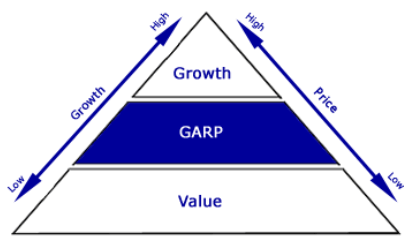Stock-Picking Strategies: GARP Investing
Tan KW
Publish date: Thu, 04 Jul 2013, 02:16 PM
Do you feel that you now have a firm grasp of the principles of both value and growth investing? If you're comfortable with these two stock-picking methodologies, then you're ready to learn about a newer, hybrid system of stock selection. Here we take a look at growth at a reasonable price, or GARP.
What Is GARP?
The GARP strategy is a combination of both value and growth investing: it looks for companies that are somewhat undervalued and have solid sustainable growth potential. The criteria which GARPers look for in a company fall right in between those sought by the value and growth investors. Below is a diagram illustrating how the GARP-preferred levels of price and growth compare to the levels sought by value and growth investors:
 |
What GARP Is NOT
Because GARP borrows principles from both value and growth investing, some misconceptions about the style persist. Critics of GARP claim it is a wishy-washy, fence-sitting method that fails to establish meaningful standards for distinguishing good stock picks. However, GARP doesn't deem just any stock a worthy investment. Like most respectable methodologies, it aims to identify companies that display very specific characteristics.
Another misconception is that GARP investors simply hold a portfolio with equal amounts of both valueand growth stocks. Again, this is not the case: because each of their stock picks must meet a set of strict criteria, GARPers identify stocks on an individual basis, selecting stocks that have neither purely value nor purely growth characteristics, but a combination of the two.
Who Uses GARP?
One of the biggest supporters of GARP is Peter Lynch, whose philosophies we have already touched on in the section on qualitative analysis. Lynch has written several popular books, including "One Up on Wall Street" and "Learn to Earn", and in the late 1990s and early 2000 he starred in the Fidelity Investment commercials. Many consider Lynch the world's best fund manager, partly due to his 29% average annual return over a 13-year stretch from 1977-1990. (To learn more about Peter Lynch, check out Greatest Investors feature.)
The Hybrid Characteristics
Like growth investors, GARP investors are concerned with the growth prospects of a company: they like to see positive earnings numbers for the past few years, coupled with positive earnings projections for upcoming years. But unlike their growth-investing cousins, GARP investors are skeptical of extremely high growth estimations, such as those in the 25-50% range. Companies within this range carry too much risk and unpredictability for GARPers. To them, a safer and more realistic earnings growth rate lies somewhere between 10-20%.
Something else that GARPers and growth investors share is their attention to the ROE figure. For both investing types, a high and increasing ROE relative to the industry average is an indication of a superior company.
GARPers and growth investors share other metrics to determine growth potential. They do, however, have different ideas about what the ideal levels exhibited by the different metrics should be, and both types of investors have varying tastes in what they like to see in a company. An example of what many GARPers like to see is positive cash flow or, in some cases, positive earnings momentum.
Because a variety of additional criteria can be used to evaluate growth, GARP investors can customize their stock-picking system to their personal style. Exercising subjectivity is an inherent part of using GARP. So if you use this strategy, you must analyze companies in relation to their unique contexts (just as you would with growth investing). Since there is no magic formula for confirming growth prospects, investors must rely on their own interpretation of company performance and operating conditions.
It would be hard to discuss any stock-picking strategy without mentioning its use of the P/E ratio. Although they look for higher P/E ratios than value investors do, GARPers are wary of the high P/E ratios favored by growth investors. A growth investor may invest in a company trading at 50 or 60 times earnings, but the GARP investor sees this type of investing as paying too much money for too much uncertainty. The GARPer is more likely to pick companies with P/E ratios in the 15-25 range - however, this is a rough estimate, not an inflexible rule GARPers follow without any regard for a company's context.
In addition to a preference for a lower P/E ratio, the GARP investor shares the value investor's attraction to a low price-to-book ratio (P/B) ratio, specifically a P/B of below industry average. A low P/E and P/B are the two more prominent criteria with which GARPers in part mirror value investing. They may use other similar or differing criteria, but the main idea is that a GARP investor is concerned about present valuations.
By the Numbers
Now that we know what GARP investing is, let's delve into some of the numbers that GARPers look for in potential companies.
The PEG Ratio
The PEG ratio may very well be the most important metric to any GARP investor, as it basically gauges the balance between a stock's growth potential and its value. (If you're unfamiliar with the PEG ratio, see: How the PEG Ratio Can Help Investors.)
GARP investors require a PEG no higher than 1 and, in most cases, closer to 0.5. A PEG of less than 1 implies that, at present, the stock's price is lower than it should be given its earnings growth. To the GARP investor, a PEG below 1 indicates that a stock is undervalued and warrants further analysis.
PEG at Work
Say the TSJ Sports Conglomerate, a fictional company, is trading at 19 times earnings (P/E = 19) and has earnings growing at 30%. From this you can calculate that the TSJ has a PEG of 0.63 (19/30=0.63), which is pretty good by GARP standards.
Now let's compare the TSJ to Cory's Tequila Co (CTC), which is trading at 11 times earnings (P/E = 11) and has earnings growth of 20%. Its PEG equals 0.55. The GARPer's interest would be aroused by the TSJ, but CTC would look even more attractive. Although it has slower growth compared to TSJ, CTC currently has a better price given its growth potential. In other words, CTC has slower growth, but TSJ's faster growth is more overpriced. As you can see, the GARP investor seeks solid growth, but also demands that this growth be valued at a reasonable price. Hey, the name does make sense!
GARP at Work
Because a GARP strategy employs principles from both value and growth investing, the returns that GARPers see during certain market phases are often different than the returns strictly value or growth investors would see at those times. For instance, in a raging bull market the returns from a growth strategy are often unbeatable: in the dotcom boom of the mid- to late-1990s, for example, neither the value investor nor the GARPer could compete. However, when the market does turn, a GARPer is less likely to suffer than the growth investor.
Therefore, the GARP strategy not only fuses growth and value stock-picking criteria, but also experiences a combination of their types of returns: a value investor will do better in bearishconditions; a growth investor will do exceptionally well in a raging bull market; and a GARPer will be rewarded with more consistent and predictable returns.
Conclusion
GARP might sound like the perfect strategy, but combining growth and value investing isn't as easy as it sounds. If you don't master both strategies, you could find yourself buying mediocre rather than good GARP stocks. But as many great investors such as Peter Lynch himself have proven, the returns are definitely worth the time it takes to learn the GARP techniques.
http://www.investopedia.com/university/stockpicking/stockpicking5.asp



















